|
The Inside of Shady Crest Orchard and Farm Market
VF[fBENXgΚχ_}[PbgΜΰ
[Note] If this page is too small to be readable, please enlarge it to 120-125%. Thank you.
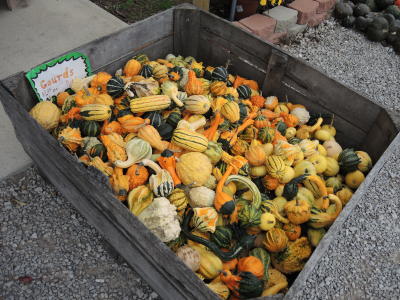
A big box of gourds were placed near the front door. One amazing thing in the American produce is that there are a plethora of gourds everywhere.
Their main usage is probably for decoration, but I heard some gourds are cooked for eating. In Japan, we have almost only one kind of gourds,
which has a look of two balls put together vertically. Its color is mostly green. (When it's dried, it gets yellow or brown.) This Japanese gourd
was used as a liquid container for lots of purposes. One typical use was for serving sake or Japanese wine made of rice. Travellors in the
samurai era carried a gourd as a convenient canteen for drinking water.
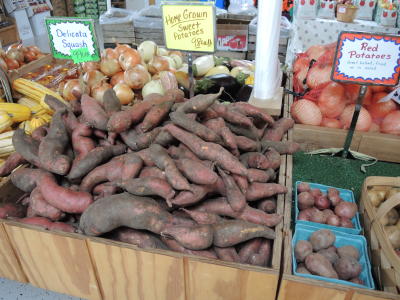
The first thing that came into my eyes as we entered inside was lots of sweet potatoes. The price tag showed 98 cents for one pound (which is
about 450grams). I think that's reasonable. On their right were red potatoes, which I ate often times when I was on American university campuses.
Then on the left-hand side were delicata squashes (those yellow ones) for 99 cents a pound. Frankly, we don't eat squashes in Japan so I don't really know how sweet
it is, but in the U.S. people bake or roast it and they say yummy. I really wanted to taste some but I could not find an opputunity for that at
restaurants we went to during this trip.
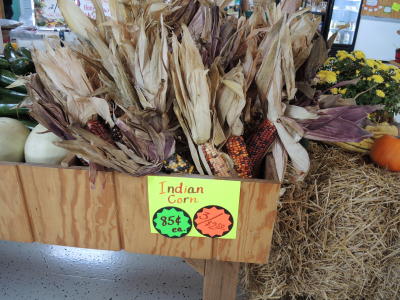
And then indian corns! This was also placed in a large space at the front part of the market. Just like delicata squash, this is mostly for decoration.
And just like delicata squash, it can be processed into something edible in the United States, I heard. In Japan we only see sweet corn and we only
light cook them, like short time grilling or boiling. But, the kernels of indian corn are very hard with very tough skins so our style of cooking
obviously doen't fit indian corn. Anyway, it's very colorful and really good for centerpiece ornaments. And it's especially wonderful for Halloween
decoration! The price at this market was 85 cents a piece and just $2.50 for three.
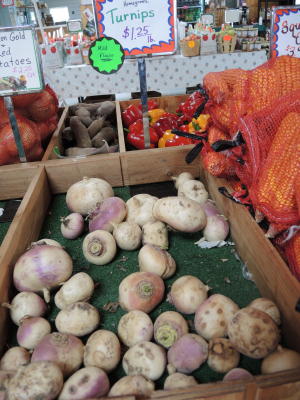
Not so many American people seem to cook turnips. But we really love turnips in Japan. Japanese turnips are winter vegetables but turnips seem to be
available in summer too in the U.S., right? Anyway, turnips are full of vitamin A, B, and C. Especially turnips are a good way to take vitamin C into our body.
I hope more American people are willing to try turnips because this is a really nutritious vegetable.
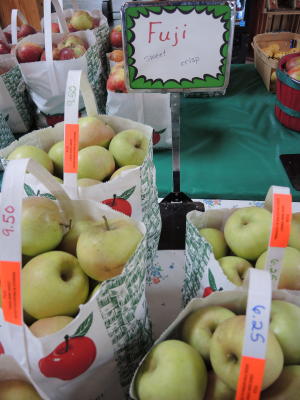
There were lots of apples placed right behind the sweet potatoes and indian corns. These are Fuji apples (even though they aren't red enough).
Needless to say, it originated in Japan, and is still popular there. In Japan we mostly eat apples raw or in salads at home. Apple pies are
popular but we usually get them at stores. Many of us don't have ovens big enough to make pies. So, favorite apples in Japan have soft and juicy
flesh rather than crunchy one.
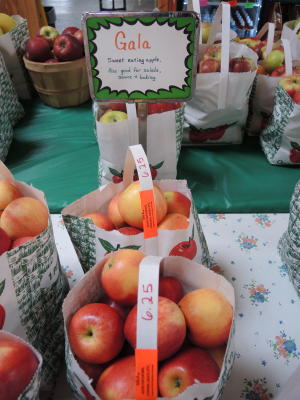
These are the Gala apples. I live in a local area of Japan, and I rarely see this type of apples. But here in the United States this seems to be
popular. According to Wikipedia, this originated in New Zealand, and was introduced to U.S. farms in 1970s. So even in here Gala is still
new. The note on the price sign was like "Sweet eating apple. Also good for salads, sauce, and baking."
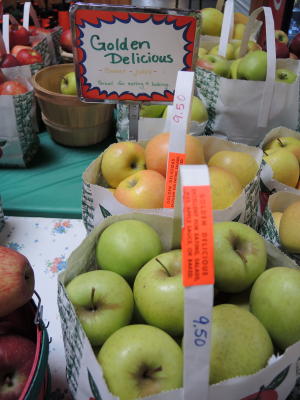
Here are Golden Delicious! Golden Delicious is an American origin, but is really popular in Japan too because it is golden (well, actually yellow
I think) and large and its flesh is very soft but crisp. At a Japanese store you may have to pay more than three dollars for just one big Golden
if it's large enough and shiny. I love Golden Delicious but it's not a usual pick because of the high price. People buy it for a special
opportunity in Japan.
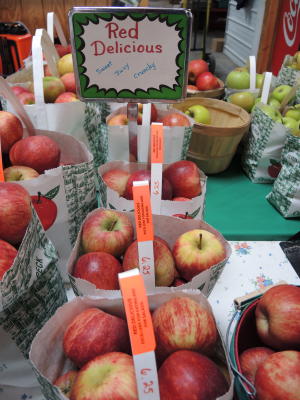
The sign stand reads these are Red Delicious. Also, the pink sticky note on the bag handle shows this is Red Delicious. But if
these were really that famous American apple type, they should be a little longer and more red. Anyway, Red Delicious has been and still now the
most popular apples in the United States, right? But I hear that status long given to this apple type is shaking now. Its skin is a little tougher
and a few new apple types are sweeter and softer. When I came over here to study at college twenty years ago, Red Delicious occupied a much larger
part of any supermarket's apple section. Now it occupies only one small space amid all the other apples. But, when somebody asks me, I still
answer Red Delicious is my number one pick. It's a good balance between sweetness and sourness, and moderately crunchy. (For some unknown reason,
this Washington apple is not available in Japan.)
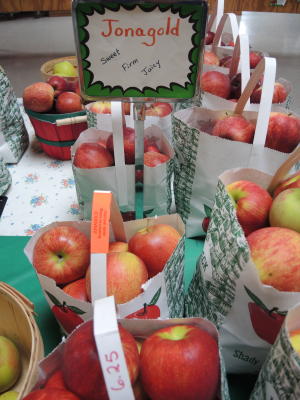
These are Jonagold. It's well known that this type was first produced from a cross between Golden Delicious and Jonathan. It's a big apple along
with Golden Delicous. Jonagold is popular in Japan too. I like Jonagold but again this comes with a high price (often times it's more than three
dollars a piece) so it's not my daily pick.
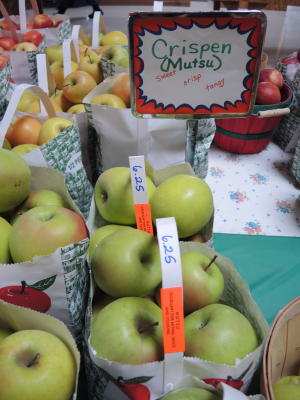
The spelling on the sign stand reads "crispen." But the correct spelling probably is "crispin." Either way, the pronunication is probably the
same in the U.S. Crispin or Mutsu was developed in Japan before World War II. Since the first market appearance, it's always been a throne in Japan
because it's soft, juicy, crispy, aromatic, and really big and beautiful above all. No need to say this is a very expensive apple along with Jonagold in Japan.
If it's really big, you might have to pay more than five dollars a piece!
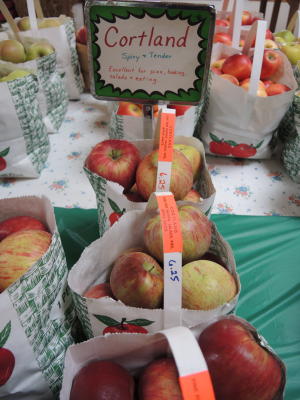
Cortland is rarely known in Japan. I personally haven't seen this apple sold at any store in Japan. An expensive import produce store in Tokyo or
Osaka may display this apple. In America, this is one of popular apples and usually advertised as an all purpose apple, right? I wish I would eat this
next time I visit the United States.
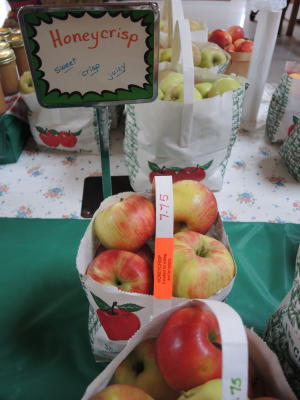
Honeycrisp is unfamiliar again in Japan along with Cortland. Wikipeida tells that this is a new comer even in the United States, just about twenty
years since it first came to market. Wikipedia also tells that when you bite one, sweet juice splashes in your mouth! Wow! I really wish I would
try this during the next visit to America.
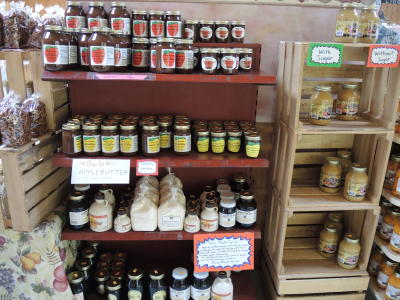
There were racks for preserves behind the apple display. This first rack held apple butter. Some were sugar added and others were not. For your
information, apple butter is a spread made with apple sauce boiled up into dense condensation. This same rack also held maple syrup, which were
produced in Michigan by another Amish families. I also saw sorghum molasses, which we rarely see in Japan. Early American settlers made sweet syrup
from sorghum, which is a wild plant native in the New World. I wish I would have brought back a couple bottles of sorghum in this trip.
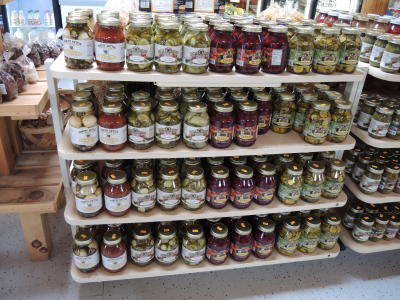
This rack held a variety of pickles: red pepper, cucumber, baby beets, and jalapeno eggs above all! We don't have a habit to pickle boiled eggs, so
I was very surprised when I saw those jars of pickled eggs, which in this photo are seen at the left hand edge of each shelf.
Click here to watch an enlarged photo of jalapeno eggs. It looks yummy, doesn't it?
If you are interested in how to cook pickled eggs, connect to You Tube and key in "pickled eggs."
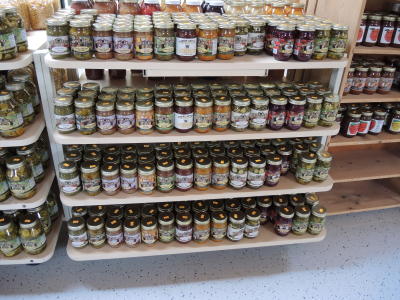
This third rack mainly displayed a variety of relish. I saw sweet zucchini relish, onion relish, corn relish, red pepper relish, garlic relish,
baby beets relish, and green tomato relish. I even found chow chow! No, that was not that famous Chinese dog breed. That was one unique kind of
American relish. I have never eaten chow chow so I really don't know how it tastes. But a recipe shows that is basically mixed chopped vegetables
with venegar and some sugar added. Again I wish I would have tried some during this trip. An enlarged photo of jarred chow chow is available by
clicking here.
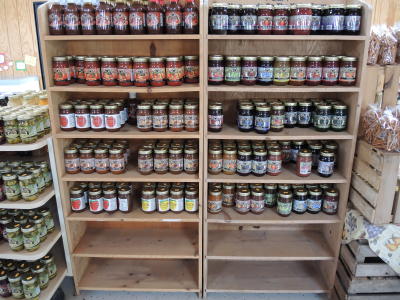
This last rack was for spread and salsa. I saw BBQ sauce. I saw garden salsa, peach salsa, and pineapple salsa. I also saw a variety of spread,
like strawberry, blackberry, blueberry, raspberry, cherry, apricot, peach, grape, and jalapeno. Besides, there were spreads that have never been
seen in Japan, such as gooseberry, elderberry, and even corncob! I was so surprised to see corncob spread that I checked it on Wikipedia after
I came back home. That should rather be called corncob jelly and is made from the liquid obtained after rolling boiled corncobs. In the
country, people have been thrifty enough to make full use of materials they get from earth! Click here
to see a photo of corncob jelly jars.
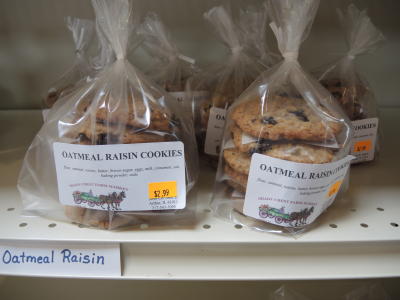
Just like the Rockome Garden cheese factory, there were tons of bagged cookies sold at this market. Here I show you just one of those: oatmeal raisin
cookes. Oatmeal is a common stable in the Western World but is very rare in Japan. Almost only a chance we see oatmeal in Japan is a cereal at an
imported food shop in a big city. Oatmeal is one of low calorie foods so I wonder why this is not so popular in Japan. A lot of Japanese women are
always interested in healthy foods good for dieting.
Day Four further continues to the next page.
lϊΪΝXΙΜy[WΦΖ±«ά·B
|













